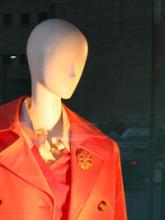How would you feel about facing a mannequinn who is an exact replica of you?
An episode of "Seinfeld" features Elaine confronting a mannequin who looks exactly like she does. At first, she is really excited by the overwhelming resemblance and makes a list of possible artists who could have possibly created such a masterpiece. That doesn't last long. When the over-bearing sales clerk takes revenge on Elaine by putting the Mannequin an sexually compromising position, Elaine is less than thrilled.
Today, I came across an article in the NYT about women and our relationships to the Mannequins we see in store windows. The writer believes that the looks of the Mannequins often affect our own self-perceptions and give us hints about what kind of bodies are most attractive.
What's in Vogue for Mannequin models these days doesn't actually reflect what's in Vogue for real women. In the interest of saving money and being as PC as possible, the mannequins preferred by most window dressers are either headless or featureless, with the faces as vaguely defined as possible. The body shapes tend to be smaller than the average size women- usually around a sized 2 or sized 4. Even Beyonce's mannequin (which was commissioned by her mother) had 4 inches taken off her hips, which are 42-inches in real life. (According to the insider quoted by the Times, most images we see of the singer are actually stretched.)
If you take the time to contast that to most current fashion runway models, you will notice quite a big difference- exotic features, ultra-enhanced make-up, and wild hair are definitely more prevalant for the models on the runways of New York, London and Milan than bland-looking models. And, of course, even the fashion industry would more than likely blink twice at a headless model walking the catwalk.
However, "realistics" (what the fashion industry calls more life-like models) are re-gaining popularity. The writer of the article suggests that possibly a tattoed mannequin model with some oomph might make a come-back. It's a nice thought, but it has yet to come to fruition.
I'm wondering whether or not a headless or faceless mannequin with a small size but somewhat larger breasts really give women (and men) an idea of an ideal size or type to strive for? An educated guess is that the reason for the small sizes is to show off the clothing, but wouldn't that change if the clothing was made for different shapes and sizes in the first place? While attractive body shapes might get the women in the dressing room to try on the clothes in the first place, couldn't it also backfire by making the women feel that the clothes look worse on them?
